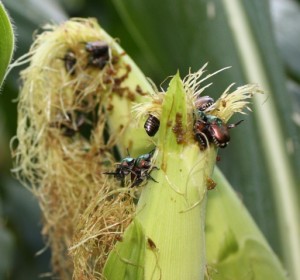
The phone has begun to ring now that Japanese beetles are out and about and we also have corn beginning to tassel. Japanese beetles will feed on corn leaves but are particularly attracted to silks. Leaf feeding is of little concern, but silk feeding draws a lot of attention. It is not uncommon to see a covey of 4-10 beetles on one ear, particularly on field edges. Naturally, this causes worries about whether this feeding reduces pollination. The answer is … it depends.
Several states, now including Tennessee, recommend treating for Japanese beetles in corn when an average of three or more beetles is found per ear during pollination. Keep in mind that almost all pollination occurs within the first 4-5 days of silk emergence under normal environmental conditions. It is also very important to remember that Japanese beetles are almost always more common on field edges. So you need to step further into a field to get a good sample of infestation levels. I seldom see treatment level infestations, but many people use Japanese beetles as an excuse to include an insecticide while spraying a foliar fungicide (see related article).
We initiated research a few years ago as part of Sandy Steckel’s graduate research to determine how much silk feeding was needed to affect pollination (kernel numbers) and yield. This included caging beetles on ears and also manually clipping silks at different times and durations. The results were very interesting.
- No matter how intense or frequent the clipping, yield was not significantly reduced unless it occurred during the first five days of silk emergence.
- Once-daily clipping of all silks also had no impact on yield, even when it was repeated on a daily basis.
- Caging four or more beetles on ears during the first five days of silking reduced the number of kernels per ear. We saw similar results when we clipped all silks with scissors several times a day during the first five days of silking.
- In several experiments, we saw no yield response even when sustained clipping reduced the number of kernels per ears. The remaining kernels in the ear got slighter heavier and compensated for the loss.
- Environment is a factor. Indeed, we only observed yield loss from silk clipping in one experiment where plants were under severe drought stress at the time of pollination. In this test, there were pollination problems even on ears that were not infested with beetles, but silk clipping during the first five days of silk emergence definitely made things worse. It took several beetles per ear to have a significant effect on yield even under these conditions.
The moral of the story is that you should be most concerned about Japanese beetles in field corn during early silking and especially if plants are under drought stress. It appears that well watered or irrigated corn is relatively immune to feeding by silk clipping insects. Fortunately, drought has not been a big issue in Tennessee this year. Our research supports the threshold suggested above. Because there is only a narrow window where Japanese beetles can impact pollination and yield, and this is a very visible insect, it is really not too tough to scout and treat as needed. If treatment is needed, the timing would typically match well with that suggested for foliar fungicide applications in Tennessee. Pyrethroid insecticides are effective and inexpensive.


One thought on “Japanese Beetles on Corn Silks”
Comments are closed.